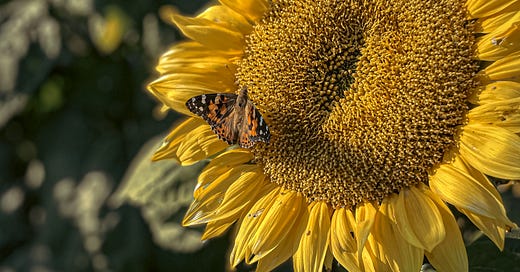Earlier this year, I was asked to share advice on how to find your calling. In an attempt to share a thoughtful response to the question, I spent several days thinking about how I relate to the inquiry. In the initial response, I mainly focused on affirming the feeling of not knowing, staying with the present moment, and encouraging grace. I recently revisited my response to see if I could draw out some of my thinking on the topic. For context, I decided to circle back as I began reflecting on my work. With over 20 years of experience as a somatic practitioner, I am contemplating how to do my work in a different way that is more joyful and sustainable. Is it possible to avoid burnout and compassion fatigue as a healthcare professional? This question applies across different vocations, and is central to the notion of having a calling—when the work that is ours to do becomes a struggle, whose care, whose memory do we seek?
When I began writing this newsletter, there was a particular place on the land that I conjured in my mind. Imagine the deepest part of a forest, where sound echoes against the body of silence. Areas like this are more familiar with increased human interference. Sometimes referred to as a glade or clearing, this grassy meadowland can occur naturally, or result from ecosystem depletion. Meadows and clearings also serve as transitional zones for plants and animals that can thrive in niche microenvironments. The liminality of edge habitats, whether inherent or enforced, holds the possibility for common ground between species.
Those of us who live at the margins—the more-than-human and human among us—understand what it means to build a home and community here. We know what it means to hold delight and love through the weft and warp of history. As the wildlife biologist, author, and poet Drew Lanham wrote, “Joy is being loved / up close / for who we are.”
For over two decades, I’ve cared for all types of bodies. I came to this work through a love of theater and performance and have since gone on to study the body through scientific and spiritual inquiry. There are myriad intersections when it comes to the body—racial, political, cultural, medical, and ecological—that reach in multiple directions through time and into the cosmos. If our bodies contain the same elements that populate the sky and soil—bodies at the threshold between heaven and earth—we know that there is more than one way to survive.
This wasn’t always the case. As a child, I was restless in my desire to understand who and where I come from. My family could always find me sitting among stacks of photo albums, between the old gramophone and the mid-century cabinet where they were kept. I poured over images and memories, dodging and burning with my eyes; retinas in search of matriarchs. On the seam of each picture, at the border of white between myself and my kin, sat our history on the lip of reclamation.
The earth of my life and the threads that have shaped me are rooted in the terra. Each season of life moves me further into the loam; craving the connection of mycelium and communion with microorganisms. I dream of their bodies gliding in between my toes, growing upwards towards my calves, and anchoring me deeper into the land. I may very well be a tree, branching my limbs and reaching into offshoots: Mother, Artist, Daughter, Gardener. Again and again, each new growth is imbued with meaning.
In all of this, this tending and tenderness, I’ve learned that life is always becoming. If we find ourselves called towards something, it is because we are interdependent within a vast network of connections. In The Book of Delights, Ross Gay writes, “If we sink a spoon into that fact, into the duff between us, we will find it teeming. It will look like all the books ever written. It will look like all the nerves in a body.” To recognize one’s calling is to be in conversation with joy and revel in the presence of those who came before. Ear to the ground, we listen for the ancestors that call us in to join them in the humus; to be exactly where we are, as we are.
Listening
“Going Home” by Ulali is a staple track that always settles the nervous system.
Reading
Still working my way through Erin Sharkey’s A Darker Wilderness: Black Nature Writing from Soil to Stars. I also recently read a stellar interview on decolonizing diet and food culture with Claudia Serrato for Atmos Magazine.
Creating
This July marks a year of writing the newsletter, and I’ve been thinking through how I’d like to shape things moving forward. I will be sharing more on this in the next essay.




